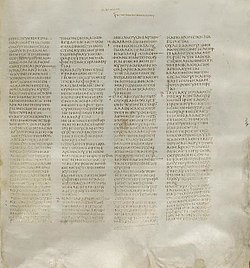Matthew 9
| Matthew 9 | |
|---|---|
 Matthew 8:28-9:23 on Codex Sinaiticus (AD 330-360). | |
| Book | Gospel of Matthew |
| Category | Gospel |
| Christian Bible part | New Testament |
| Order in the Christian part | 1 |
| Gospel of Matthew |
|---|
|
Chapters |
Matthew 9 is the ninth chapter of the Gospel of Matthew in the New Testament and continues the narrative about Jesus' ministry in Galilee as he ministers to the public, working miracles, and going through all the cities and towns of the area, preaching the gospel, and healing every disease.[1]
Text
- The original text is written in Koine Greek.
- Some most ancient manuscripts containing this chapter are:
- Codex Vaticanus (AD 325-350)
- Codex Sinaiticus (AD 330-360; complete)
- Codex Bezae (ca. AD 400)
- Codex Washingtonianus (ca. AD 400)
- Codex Ephraemi Rescriptus (ca. AD 450; complete)
- Minuscule 828 (Codex 828; 12th century)
- This chapter is divided into 25 verses.


Structure
This chapter can be grouped (with cross references to other parts of the Bible):
- Matthew 9:1–8 = Healing the paralytic at Capernaum (Mark 2:1–12; Luke 5:17–26)
- Matthew 9:9–13 = Calling of Matthew (Mark 2:13–17; Luke 5:27–32)
- Matthew 9:14–15 = On fasting (Mark 2:18–22}; Luke 5:33–39)
- Matthew 9:16–17 = New Wine into Old Wineskins (Mark 2:18–22}; Luke 5:33–39)
- Matthew 9:18–19,23–26 = Daughter of Jairus (Mark 5:21–24,35–43}; Luke 8:40–42,49–56)
- Matthew 9:20–22 = Jesus healing the bleeding woman (Mark 5:25–34}; Luke 8:43–48)
- Matthew 9:27–31 = Healing the two blind men in Galilee (Mark 10:46–52)
- Matthew 9:32–34 = Jesus exorcising a mute
- Matthew 9:35–38 = Good crop but few harvesters
Cross reference
Raising of Jairus' Daughter and Healing of the Bleeding Woman
In the Gospel of Luke, the miracles follow the exorcism at Gerasa. Back in Galilee, Jairus, a patron or ruler of a Galilee synagogue, had asked Jesus to heal his 12-year-old daughter, who was dying (in Matthew's account, Jairus used hyperbolic expressions in his anxiety: ‘My daughter is even now dead’). As they were travelling to Jairus' house, a sick woman in the crowd touched the border (or possibly the fringe) of Jesus' cloak and was healed of her sickness. Jairus' daughter was then reported as having died, and Jairus was therefore advised not to trouble Jesus, 'the teacher', any further. Jesus, however, continued to the house, stating that the girl was not dead but asleep, and restored her to health. The chapter ends with Jesus' mandate that Jairus and his wife should tell no-one what had happened.
Tzitzit
Matthew's (and Luke's) accounts specify that the bleeding woman touched the "fringe" of his cloak, using a Greek word kraspedon which also appears in Mark 6.[2] According to the Catholic Encyclopedia article on fringes in scripture, the Pharisees (one of the sects of Second Temple Judaism) who were the progenitors of modern Rabbinic Judaism, were in the habit of wearing extra-long fringes or tassels (Matthew 23:5), a reference to the formative çîçîth (tzitzit). Because of the Pharisees' authority, people regarded the fringe with a mystical quality.[3]
See also
| Preceded by Matthew 8 |
Chapters of the New Testament Gospel of Matthew |
Succeeded by Matthew 10 |
References
- ^ Hawker, Robert. "Hawker's Poor Man's Commentary Matthew 9". Study Light. Retrieved June 2, 2015.
- ^ κράσπεδον/kraspedon, see Strong's G2899
- ^ Knight, Kevin (2009), "Fringes (in Scripture)", The Catholic Encyclopedia, retrieved 30 December 2011
